
About UsThe Numismatic Bibliomania Society is a non-profit organization promoting numismatic literature. For more information please see our web site at coinbooks.org SubscriptionsThose wishing to become new E-Sylum subscribers (or wishing to Unsubscribe) can go to the following web page link MembershipThere is a membership application available on the web site Membership Application To join, print the application and return it with your check to the address printed on the application. Membership is only $15 to addresses in the U.S., $20 for First Class mail, and $25 elsewhere. For those without web access, write to: David M. Sundman, Secretary/TreasurerNumismatic Bibliomania
Society AsylumFor Asylum mailing address changes and other membership questions, contact David at this email address: dsundman@LittletonCoin.com SubmissionsTo submit items for publication in The E-Sylum, just Reply to this message, or write to the Editor at this address: whomren@coinlibrary.com
BUY THE BOOK BEFORE THE COINYou won't regret it! |
- WAYNE'S WORDS: THE E-SYLUM FEBRUARY 7, 2010
- THE ASYLUM OCTOBER-DECEMBER 2009 ISSUE PUBLISHED
- DAVID SKLOW SALE #9 CLOSES FEBRUARY 13, 2010
- NEW BOOK: SMALLFOREST'S 2010 SO-CALLED DOLLARS
- HERITAGE OFFERS 1785 ADAMS COMITIA AMERICANA MEDALS LETTER
- THE P. SCOTT RUBIN NUMISMATIC LIBRARY
- WHY EARLY RED BOOKS ARE RARE
- INTERVIEW WITH SMITHSONIAN NUMISMATIC CURATOR RICHARD DOTY
- QUERY: EARLIEST FIVE-POINTED STAR ON A U.S. COIN
- A NUMISMATIC AUTHOR'S DILEMMA
- MORE ON SPANISH-AMERICAN EIGHT REALES METROLOGICAL DATA
- FOOD RATION COUPONS IN EARTHQUAKE-RAVAGED HAITI
- MORE ON ATMS AND BANKNOTE DENOMINATIONS
- SOME MORE CENTRAL INTELLIGENCE AGENCY MEDALS
- ARTICLE HIGHLIGHTS THE DETROIT CHEER AND OTHER LOCAL CURRENCIES
- AN OPEN LETTER TO CONGRESS, THE TREASURY AND MINT OFFICIALS
- GIACOMETTI SCULPTURE PICTURED ON BANKNOTE NETS $104 MILLION
- DICKIN MEDAL TO BE PRESENTED TO BOMB-SNIFFING DOG
- THE NFL'S SUPER BOWL COIN TOSS STREAK
- QUERY: DEAR JOHN MOVIE'S NUMISMATIC SUBTHEME
- FEATURED WEB SITE: A HISTORY OF THE WORLD
WAYNE'S WORDS: THE E-SYLUM FEBRUARY 7, 2010

Among our new subscribers this week are Greg Ingram, Cynthia R. Smith, and J. A. McNerney. Welcome aboard! We now have 1,322 subscribers.
Sorry for the late publication, folks. This issue is going out Monday afternoon instead of the usual late-night Sunday. We had a record-breaking snowstorm over the weekend (well over two feet), and lost power for nine hours, but that wasn't the problem. The problem was just a glitch on the Binhost servers that send out the newsletter. I was up late finishing it last night, but couldn't publish.
The problem has been fixed, and the delay enabled me to include a note about the latest issue of The Asylum. Between working my day job and shoveling snow I was unable to edit everyone's submissions this week. We'll get some of them into the next issue.
We've got some interesting topics this week, including the latest use of food coupons and the Super Bowl coin toss. To learn about the Dog Who Deserves a Medal and why early Red Books are so rare, read on.
Wayne Homren
Numismatic Bibliomania Society
THE ASYLUM OCTOBER-DECEMBER 2009 ISSUE PUBLISHED
 I've sent another issue of The Asylum to the printers: volume 27, number 4.
Here are the contents:
I've sent another issue of The Asylum to the printers: volume 27, number 4.
Here are the contents:
- David Fanning and Eric Newman - An Eighteenth-Century Coin Chart: A Mystery Solved
- Myron Xenos - "You Don't Say": Numismatic Quiz
- Pete Smith - So Who Is This George Kolbe, Anyway?
- Leonard Augsburger and Joel Orosz - The Numismatic Bulldog: Tales from the Road
- Dave Hirt - A Unique Buying Opportunity
DAVID SKLOW SALE #9 CLOSES FEBRUARY 13, 2010
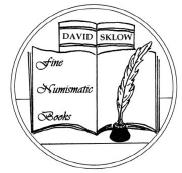 DAVID SKLOW - FINE NUMISMATIC BOOKS Sale #9 Closes Saturday February 13, 2010. Highlights include:
DAVID SKLOW - FINE NUMISMATIC BOOKS Sale #9 Closes Saturday February 13, 2010. Highlights include:
- 1942 studio photo of Abe Kosoff and B. Max Mehl at the ANA Convention Banquet;
- Editor's copies of several of Q. David Bower's works;
- QDB's First Fixed Price List;
- QDB's unpublished manuscript on Colonials;
- The Horace L.P. Brand original correspondence;
- The original correspondence of Walter P. Nichols;
- The papers of Robert Morris six volume set;
- J. H. Jongkee's The Kimonian Dekadrachms;
- Complete bound set [108 volumes] 1892-2000 of the Spink Numismatic Circular;
- Research files and typescript for the Dr. George Wilkins work;
- numerous works on treasure hunting, pirates and ship wrecks;
- Columbiana by Eglit;
- Deluxe bound Bluestone set of Grinnell catalogs;
- Kagin's 1977 ANA catalog deluxe leather edition;
- numerous deluxe bound editions of Bowers, Federal Brand, Ivy, Kagin, Katen, Kosoff, Kelly, Kreisberg, Lepczyk, Merkin, NASCA,
- A long run of deluxe and plated deluxe Superior catalogs;
- U.S. Cents 1798-99 by Clapp;
- Newcomb 1944 deluxe leather both thin & thick paper editions;
- over 300 individually listed auction catalogs of the 19th Century;
- Howard Newcomb's copy of Ed Lee's California Gold book;
- Breen & Gillio deluxe morocco leather #24 of 100 California Pioneer Gold book;
- Kagin's Pioneer Gold work in a deluxe full leather boxed edition;
- Part one of the Rev. Clunan British Works library, and much, much more.
www.finenumismaticbooks.com PH: (719) 302-5686, FAX: (719) 302-4933. EMAIL: numismaticbooks@aol.com. USPS: Box 6321, Colorado Springs, CO. 80934.
NEW BOOK: SMALLFOREST'S 2010 SO-CALLED DOLLARS
 "Smallforest's 2010 So-Called Dollars" is now for sale.
The booklet, in approx. 35pps gives the average selling price of the SCD's listed in Hibler & Kappen's "So-Called Dollars," in
three conditions ranging from AG-VF up to Unc-BU.
"Smallforest's 2010 So-Called Dollars" is now for sale.
The booklet, in approx. 35pps gives the average selling price of the SCD's listed in Hibler & Kappen's "So-Called Dollars," in
three conditions ranging from AG-VF up to Unc-BU.
Each medal is also assigned an occurrence rating based upon the number of recorded purchase and sales transactions per medal. This year's book draws upon more than 16,000 individual transactions observed at coin shows, major auctions and on eBay.
It can be purchased at Medalzine.com, on Amazon, and at major coin shows. Cost is $24.95 plus s/h.
To read the complete article, see: www.Medalzine.com
HERITAGE OFFERS 1785 ADAMS COMITIA AMERICANA MEDALS LETTER
Every so often, a few lots that we think will be of interest to numismatists will surface in one of our non-coin auctions. Here are a few such items featured in the upcoming 2010 February Signature Historical Manuscripts Auction, to be held in Beverly Hills February 11-12:
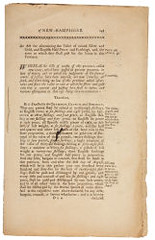 New Hampshire Colonial Imprint Fixing the Value of Silver and Gold Coin and Usury Rates. This interesting 1765 document reveals the confusion — both before and after its enactment — that foreign coins created in the colonies. It would not be until 1792 that the first half dimes and a few copper cents patterns were struck by the new United States mint, and foreign coins would remain legal tender until 1857.
New Hampshire Colonial Imprint Fixing the Value of Silver and Gold Coin and Usury Rates. This interesting 1765 document reveals the confusion — both before and after its enactment — that foreign coins created in the colonies. It would not be until 1792 that the first half dimes and a few copper cents patterns were struck by the new United States mint, and foreign coins would remain legal tender until 1857.
This printed tract contains two Acts. The first, "An Act for ascertaining the Value of coined Silver and Gold," sets standard values for English, Spanish, and Portuguese coins. It also defines the "Penalty for passing gold or silver at any other rate," decrees that "All contracts to be understood for this money; all accounts to be kept accordingly," and establishes "How former debts are to be estimated." The second Act restricts "taking excessive interest for the loan of money... wares, merchandize or any other personal estate whatsoever," and decrees "No interest to be allowed above six per cent."
The document is lightly age toned with occasional foxing and a few small chips/tears along edges. Generally very good condition. Estimate: $2,000 - $3,000. =
 John Adams Autograph Letter Signed (1785), requesting Parisian bankers Messieurs Van den Yvers to arrange payment for medals and swords by drawing on the Dutch banking consortium that was managing the Netherlands' loan to the United States.
John Adams Autograph Letter Signed (1785), requesting Parisian bankers Messieurs Van den Yvers to arrange payment for medals and swords by drawing on the Dutch banking consortium that was managing the Netherlands' loan to the United States.
Congress had voted to award six Gold Medals during the Revolutionary War, the first three to George Washington, Horatio Gates, and Nathanael Greene. John Adams and Thomas Jefferson were delegated to assist Colonel David Humphreys in the task of procuring these medals and presentation swords, to be expertly crafted in France.
Colonel Humphreys asked the aid of the French Academy of Inscriptions and Belles-Lettres in the composition of the designs. A "who's who" of legendary French engravers participated in the execution of this first group of medals. Parisian artist Pierre Duvivier struck the first Congressional Gold Medal in 1789. Augustin Dupré designed the Greene, the John Paul Jones, and others; Nicolas Marie Gatteaux was responsible for the Gates medal.
Adams wrote this letter from the Paris suburb of Auteuil just weeks before sailing to London to begin service as the first U.S. Minister to Great Britain. The letter has light horizontal folds, very clear and legible writing, overall very fine. Estimate: $40,000 - $50,000.
To read the complete article, see:
Seldom Seen Selections: Numismatic-Themed Highlights from our Manuscripts Auction
(coins.ha.com/common/newsletter.php?
id=3003&type=coinnews-tem013010)
THE P. SCOTT RUBIN NUMISMATIC LIBRARY
In a note to bibliophile P. Scott Rubin this week, George Kolbe wrote:
Below is my mind-picture of your library, Scott, formed over the years by your descriptions of it.
Actually, it is from the Daily Telegraph. Last week the newspaper printed the picture which won their weekly "Big Picture" competition.

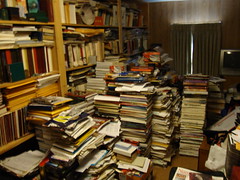
Scott adds:
The library is being reorganized and that is why so many piles are in the middle of the room. Also, not pictured are the shelves that contain the Stack's (up till 1995), Woodward, Chapman and Mehl catalogs. Also the shelves that house 19th century, numismatic literature sales and better special editions. These are all in the same room but on walls not in the photo.
WHY EARLY RED BOOKS ARE RARE
Numismatic literature dealer Charles Davis writes:
The rarity of early Red Books explained. Makes a nice presentation inscription of the flyleaf!

THE BOOK BAZARRE
INTERVIEW WITH SMITHSONIAN NUMISMATIC CURATOR RICHARD DOTY
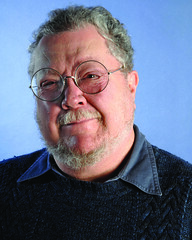 For 24 years, Richard Doty has been entrusted with the keys to the Smithsonian’s National Museum of American History’s legendary coin vault, which houses some of the most important coins in the world. Doty’s "America’s Money, America’s Story" is one of the most respected books on the subject of U.S. coins and currency, and his next book with Whitman Publishing, "Pictures From a Distant Country," will focus on obsolete U.S. currency.
For 24 years, Richard Doty has been entrusted with the keys to the Smithsonian’s National Museum of American History’s legendary coin vault, which houses some of the most important coins in the world. Doty’s "America’s Money, America’s Story" is one of the most respected books on the subject of U.S. coins and currency, and his next book with Whitman Publishing, "Pictures From a Distant Country," will focus on obsolete U.S. currency.
When I was growing up in Oregon in the 1950s, early ’60s, we were still using silver dollars. When you’ve got something like that in your hand, you know it’s money—it has heft, it has weight. It’s funny: I wrote an entire book on obsolete bank notes, but I never actually collected them.
I think I’m probably more of a world collector than a U.S. collector. I have some U.S. coins, and I used to like U.S. large cents when I was younger, but I’ve been collecting ancients and world stuff more than anything else. In my job here at the Smithsonian, I have to know a little about everything, basically. I’m curator of everything, from ancient Greek to modern U.S.
I wrote this book on obsolete currency called "Pictures From a Distant Country." The book, which is being published this year by Whitman, focuses on the images on 19th-century obsolete currency, the stuff that we used until the Civil War got us into Federal currency. These images tell us a lot about how the people of the time thought about everything from the role of women to African Americans, who were still slaves. The notes also reveal how the country viewed Native Americans, which industries were most important, and what progress and national identity meant.
If you want to see what a locomotive in 1855 looked like, there are daguerreotypes for that, but if you want to see what it meant to the nation, take a look at a note with a train on it, spewing fire and steam and chugging its way into the future.
I was only able to write that book because the collection of obsolete currency here at the Smithsonian is superb. It’s the best one I’ve ever seen.
Before I came to Smithsonian I had been at the American Numismatic Society in New York. Toward the tail end of my time at the ANS, probably from beginning of the 1980s, I got into numismatic technology—how the actual coins and notes were made. That’s been a pretty consistent interest of mine ever since.
Two areas that I collect now are errors and oddball things. Mints are secretive affairs, and paper printers are even more secretive. They don’t like you looking at the machinery that produces the coins or currency because you might get inspired to go home do it yourself. So, if you are interested in technology in terms of how this stuff was made, the coins or notes are your best witnesses, and the ones that didn’t come out quite right are the best witnesses of all.
To read the complete article, see:
An Interview with Smithsonian Coin and Currency Curator Richard Doty
(www.collectorsweekly.com/articles/an-interview-
with-smithsonian-coin-and-currency-curator-richard-doty/)
QUERY: EARLIEST FIVE-POINTED STAR ON A U.S. COIN
Mark Borckardt writes:
What is the earliest appearance of a five-pointed star on any U.S. Federal regular-issue coin?
A NUMISMATIC AUTHOR'S DILEMMA
A friend asked me about a subject that I have never had to consider in the past. Many years ago, numismatist #1 wrote a small book about the die varieties of one particular coin. A few years ago, numismatist #2 took #1's book, copied it and added many more varieties for this one particular coin in a second book. I do not know if #2 acknowledged #1's work in his book.
My friend wants to write a third reference about this particular coin and add even more die varieties. Neither #1 or #2 copyrighted their books.
My friend wants to know if he there is any illegal about copying the information from the #1 and #2 books and adding it to his book and copyrighting his book? And he wants to know how he should acknowledge the work of #1 and #2?
If one of the authors created a numbering scheme that author #3 would like to use, then permission should be sought. The same goes for photographs – if author #3 expects to use photos from the earlier books, he would need permission for that. But a book with all new photos and text is probably fine, even if it closely mimics the arrangement of the earlier books.
It's a good question that hopefully has a solution that enables author #3 to publish. What are your thoughts, readers? -Editor
THE BOOK BAZARRE
MORE ON SPANISH-AMERICAN EIGHT REALES METROLOGICAL DATA
Tom Kays writes:
In answer to Chris Faulkner's recent E-Sylum question about the metrology of pillar dollars, see www.dinsdoc.com/sumner-1.htm
Author: Sumner, W. G.
Title: "The Spanish Dollar and the Colonial Shilling."
Citation: American Historical Review 3 (July 1898): 607-19.
THE SPANISH DOLLAR AND THE COLONIAL SHILLING
THE object of the present paper is to state the results of an investigation of two questions: (1) What ought the Spanish piece of eight to have been, in weight and fineness, according to the mint laws of Spain, when it was adopted into the monetary system of Anglo-America? and (2) what was it in fact by weight and assay?
Alan Luedeking writes:
The obvious choice for all of them is Humberto F. Burzio's superb Diccionario de la Moneda Hispano-Americana. For even more detailed information, also consult Buzio's La Ceca de Lima, 1565 - 1824, and La Ceca De La Villa Imperial De Potosí Y La Moneda Colonial.
For Mexico also consult Alberto Francisco Pradeau's 4-volume work The Numismatic History of Mexico.
To read the earlier E-Sylum article, see: QUERY: SPANISH-AMERICAN EIGHT REALES METROLOGICAL DATA SOUGHT (www.coinbooks.org/esylum_v13n05a11.html)
FOOD RATION COUPONS IN EARTHQUAKE-RAVAGED HAITI
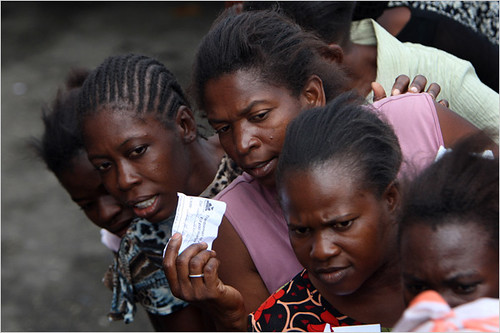
Four days into a new food distribution program from the United Nations that aims to repair a faltering aid effort, paper coupons that can be redeemed for 55 pounds of rice have become more valuable than Haitian money.
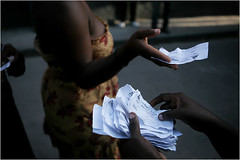 Women hide them away in their bosoms. Aid workers count them furtively in the back of S.U.V.’s. The government wants control over who gets them, while schemers have already created counterfeits.
Women hide them away in their bosoms. Aid workers count them furtively in the back of S.U.V.’s. The government wants control over who gets them, while schemers have already created counterfeits.
The food coupons are akin to diamonds: they are precious because sustenance is scarce. For three weeks since the international effort to feed millions of Haitians has been dogged by confusion, transportation snags, security problems and a lack of coordination. Before the coupon program started on Saturday, food giveaways had become a Darwinian sport — with biscuits and bottles of canola oil or biscuits thrown like footballs from the backs of trucks to masses of men jockeying for position.
To read the complete article, see:
Coupons Ease Chaos in Efforts to Feed Haitians
(www.nytimes.com/2010/02/03/world/americas/03haiti.html
?scp=1&sq=haiti%20food%20coupon&st=cse)
MORE ON ATMS AND BANKNOTE DENOMINATIONS
Joe Boling writes:
On the subject of notes dispensed by ATM machines, the local Kroger grocery has a self-checkout lane. If you pay by debit card, it asks you if you want cash back. My wife and I occasionally ask for some, and then regret it - the machine dispenses only $5 bills. They stack up in the wallet in a hurry.
Tom DeLorey writes:
I am old enough to remember when ATM machines dispensed $5, $10 and $20 bills. Heck, I can remember when tellers did it.
I suspect that the banks switched to only $20's because many bank customers got in the habit of withdrawing as little money as possible at a time, lest they run the risk of having too much and somehow losing it.
Our coin shop is around the corner from what used to be the First National Bank of Chicago. Several years ago they announced that they were going to begin to charge a service fee for ATM withdrawals over a certain number of transactions per month. A customer who worked there told me that this was because many of the ladies who worked in the building, or nearby buildings, would come to the lobby on their lunch hour and withdraw $10 for lunch money every single day. The lines at the machines were horrendous.
Using only $20s cuts down on the total face value of bills that the bank has to tie up in the machine, as well as guaranteeing a $20 minimum transaction
Rich Mantia writes:
A few years back I worked for an armored car service that replenished ATM machines. At that time I regularly installed 5, 10, 20, 50, and 100 dollar notes in the machines. The denomination used depended on where the unit was located for traffic volume and what the business owner preferred be dispensed to his/her customers.
Typically, inner city, crime ridden areas had small denominations as well as machines used in colleges or other schools. Essentially, those groups who are financially challenged on a daily basis couldn't withdraw a 20 if they didn't have the available funds, but they could get a 5 or a 10.
People would withdraw money and pay the transaction fees and have less than 5 dollars in their accounts. Living week to week and hand to mouth is more common than most people think.
The denominations of 5, 10, and 50 were being phased out because the bookkeeping and cash handling was becoming cost prohibitive and it was easier to load the machines with all 20's or with 20's and 100's instead of all the denominations which would occupy more dispenser "cassettes" and thus limit the total dollar amount to be dispensed by the machine between services.
All the ATM machines are monitored as to the average volume and the average amount of withdrawal per transaction in order to optimize the amount of currency needed. As an example, one wouldn't load a machine with 50,000 dollars if it only used $12,000 on average between services because this would tie up money that is sitting in a machine and not making any profit through interest.
The use of 20's is the most common now at most locations, however it is common for 100 dollar machines if you frequent casino's because they want you to part with as much of your money as possible as fast as possible. It was normal for me to replenish a Casino machine 2-3 days a week and a typical Walgreen's in a busy city location would take $60,000 to $80,000 each visit in 20's and a casino machine would take $150,000 to $200,000 in 100's with multiple machines on site in case of a machine running out of cash.
As a side, I watched a disguised semi being unloaded in the Chicago Federal Reserve docks direct from the BEP with pallets of "bricks" of 100's. They took 20 pallets off with a forklift and I mathematically figured that the truck contained about half billion dollars in new currency. One never knows what passes you by as you drive down the expressway!
To read the earlier E-Sylum article, see: MORE ON THE SPENDING PSYCHOLOGY OF MONEY DENOMINATIONS (http://www.coinbooks.org/esylum_v13n05a10.html)
SOME MORE CENTRAL INTELLIGENCE AGENCY MEDALS
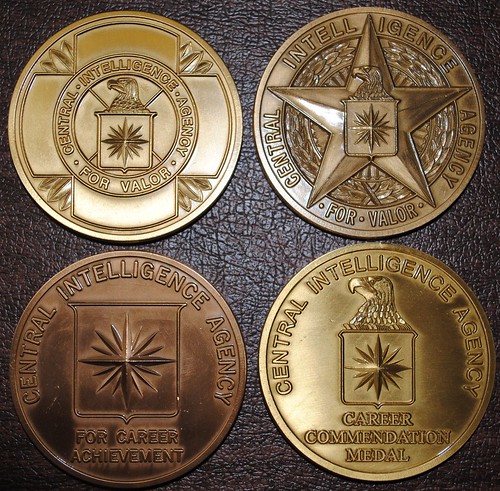
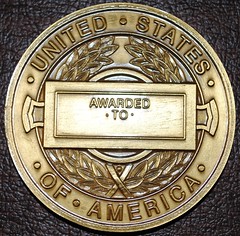
The above group all have the same "Awarded To" reverse seen last week.
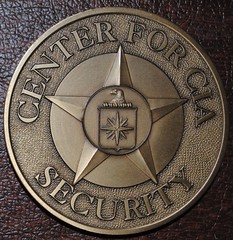
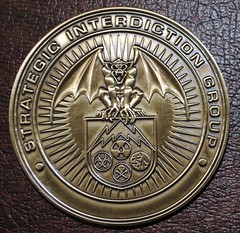
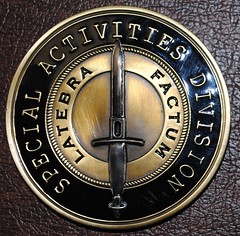
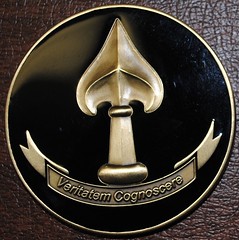
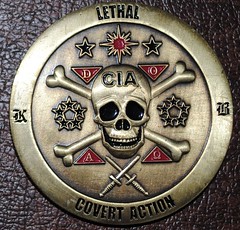
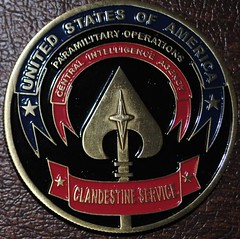
You don't see medals like THAT every day. Creepy, yet fascinating. It would be very interesting to learn about the designers and manufacturers of the medals, even if we may never know the recipients or their deeds.
To read the earlier E-Sylum article, see: MORE ON CENTRAL INTELLIGENCE AGENCY MEDALS (www.coinbooks.org/esylum_v13n05a12.html)
ARTICLE HIGHLIGHTS THE DETROIT CHEER AND OTHER LOCAL CURRENCIES
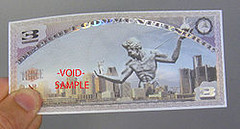 In an echo of the Great Depression, local currencies with their own special flavors are popping up all over in attempts to give commerce and communities a lift.
In an echo of the Great Depression, local currencies with their own special flavors are popping up all over in attempts to give commerce and communities a lift.
Last year, two Detroit tavern owners were sitting at the bar, sampling their beverages and bemoaning the local economy -- no one in the city had cash, and when they did, they spent it in the suburbs. Then the pair hit on a solution: Print their own money.
It is, after all, perfectly legal for anyone to issue currency, as long as it doesn't look too much like a U.S. dollar. Thus was born the Detroit cheer, a local scrip accepted by a handful of city businesses, including a pizzeria, an electrician and a doggy day care center.
Residents can also exchange it at a few area bars for greenbacks, but the cheer is vastly more colorful. It features a chiseled, naked Greco-Roman superhero (the Spirit of Detroit) towering Godzilla-like over the city skyline, cupping a tiny family in one hand and a sunburst representing God in the other.
And Detroit isn't the only city sporting its own currency. Since the market tanked nearly 18 months ago, there's been an interest in local scrips not seen since the Great Depression.
To read the complete article, see:
Struggling towns printing their own cash
(wpcontent.answers.com/wikipedia/en/thumb/
2/29/Detroit_cheer.jpg/250px-Detroit_cheer.jpg)
THE BOOK BAZARRE
AN OPEN LETTER TO CONGRESS, THE TREASURY AND MINT OFFICIALS
To the credit of Numismatic News writer Darrin Lee Unser, he found a statement buried deep in President Obama's fiscal Year 2011 Budget, just released. He found the section "Other Savings: Coinage Material - Department of the Treasury."
Faced with volatile coinage metal prices, the U.S. Treasury is still attempting to solve what metal composition in which to strike cent coins. Instead of looking into the future for the need to even have low denomination coins, Treasury officials persist in seeking piecemeal solutions. This is in contraposition to the statement by Mint Director Edmund Moy two years ago to examine the entire coinage structure.
The Treasury needs to consult a futurist instead of bowing to the pressure of numerous lobbyists, most notable the zinc industry lobby which is backing Americans for Common Cents. Their lobbying efforts have been successful to the present to retain the cent coin.
A futurist would undoubtedly submit that cents and nickels should be abolished. The economic need for these coins no longer exists, and would decrease even more so in the future. Polls reveal that citizens still want cent and nickel coins around.
The only apparent reason for this is nostalgia. However, this nostalgia is costing American business millions of dollars every day in having to inventory, handle and dispense these low value coins. Tremendous savings would occur across the spectrum of individuals, business and government if the U.S. Mint would cease their manufacture.
All prices would remain the same, right down to the lowly cent. It is only the transaction amount -- what Canadians call the "tally amount" -- which would be rounded off to the nearest 10 cent amount, the lowest denomination coin proposed to circulate. Studies have shown that the criticism "venders would always round up to the extra cost to the consumer" is not valid. One Pennsylvania study proved the cost would be less than one dollar per year for an average family, if that.
The number of countries which have abolished their lowest denominations coins is growing, following the lead of Australia and New Zealand. It has been an over whelming success in all these countries.
What coins should America have in the future? Dime. Half dollar. And Dollar, certainly. To these should be added a new Five Dollar and Ten Dollar coin. Coins are necessary for small cash transactions. Paper and electronic transfer would still remain for large transactions. A futurist would agree coins will still be absolutely necessary far into the future. We will always have small transactions, from vending machine purchases to incidental purchases. The vending machine industry would certainly welcome coins available in the above denominations (this would eliminate their greatest nuisance criticisms of problems accepting paper dollars).
To satisfy Director Moy's request to examine the entire coinage structure, here are proposed coins that will be needed in the future and their specifications:
- Dime -- 20mm Ceramic coated aluminum.
- Half Dollar -- 25mm Bronze coated zinc.
- Dollar Coin -- 30mm Copper nickel clad bronze with security edge.
- $5 Coin -- 35mm Nickel clad copper nickel alloy with security edge..
- $10 Coin -- 40mm Silver clad copper nickel alloy with microchip.
- $20 Coin -- 45mm Silver clad nickel with microchip and other security devices
- $50 Coin -- 50mm Coinage silver alloy with microchip and other security devices.
First you will note that each denomination is 5mm larger than the previous denomination. This size is perceptible to differentiate each denomination in the dark or even by the blind. The dollar coin is approximately the size of the present dollar coins.
The compositions are chosen for the following reasons: 1) They are in line with present and future costs, they would eliminate the metal costing more than its face value. 2) They purposely have several elements to discourage counterfeiting. 3) They each have a different color and weight for easy perception by inspection alone. 4) They are typical coinage metals with existing experience in coining technology. 5) They increase in value with each higher denomination. 6) The aspect of their scrap technology is taken into consideration for present coins when they will have to be recoined well into the future.
The U.S. Treasury should take two immediate actions. Take the suggestion of Chicago Federal Reserve Bank Economist Francois Velde and "rebase" the cent -- and the nickel -- to have a value of 10cents. This can be done by a fiat proclamation. Demand that all transactions be rounded off the the nearest 10cents. These coins and current dimes would be placed in the 10cent slot in cash registers.
Second, start engineering a new mint for the exclusive manufacture of the dime coin. I am not asking that sand (source of ceramic) and bauxite (source of aluminum) enter one end and dimes come spewing out the other. But engineer a mint where 20mm aluminum blanks would be struck then coated with a ceramic surface. Perhaps the ceramic could even be imprinted in color with a variety of designs. Since aluminum is easily coined, perhaps a press could strike 40 or 50 coins with every cycle of the press. After the ceramic is applied, imprint a different state design on the ceramic surface, for example.
Say it takes ten years to create such a mint. All cents and nickels would stay in circulation for that time -- at a value of 10cents each. After ten years these coins would be recalled to be melted and reformulated to be recoined.
The copper coated zinc was a brilliant choice for cents since 1982. It can easily be reformulated to brass, or used intact to coat the zinc core. The zinc industry should spend half of what they are spending for their unnecessary lobbying efforts to keep the cent. Instead spend this on research to coat bronze on zinc for a larger Half Dollar coin. Instead of whining and being an obstructionist they can actually make more money providing bronze coated zinc blanks for coining into Half Dollars well into the future.
Scrapping the copper nickel metal in five cent coins can provide the metal to be recoined into the Dollar to $10 coins by adding various clad operations.
A lot of thought has gone into this proposal. This is what future coins could be.
If you wish to read Darrin Lee Unser's article click on:
Coin Composition Changes Proposed Yet Again, but Now in Obama’s Budget
(http://www.coinnews.net/2010/02/04/coin-composition
-changes-proposed-yet-again-but-now-in-obamas-budget/)
GIACOMETTI SCULPTURE PICTURED ON BANKNOTE NETS $104 MILLION
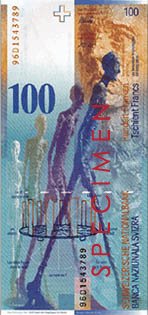
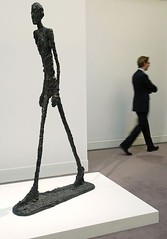
So big spenders are cutting back? Clearly not all of them. A sculpture of a grimly determined walking man by Alberto Giacometti tonight broke records by becoming the most expensive work of art ever sold at auction when it was bought for £65m.
The price, achieved at Sotheby's in London, was five times more than its estimate of £12m-18m, and beat the record set by Picasso's Garçon à la Pipe in 2004. That sold in New York for $104,168,000. With exchange rates the way they are the Giacometti pipped it at $104,327,006.
It was a recession-defying sale with something of a circular feel to it: the only reason it was up for auction was the banking crisis. It was part of the collection of the collapsed Dresdner Bank – bought in the 1980s – and was being sold by its new owners Commerzbank which promised to give all the money to charitable foundations.
For the buyers and their representatives, the Giacometti sale was probably a once in a lifetime opportunity. The sculpture is considered to be one of the most important by the 20th-century Swiss artist.
To read the complete article, see:
Alberto Giacometti statue breaks auction record with £65m sale
(www.guardian.co.uk/artanddesign/2010/feb/03/
giacometti-statue-breaks-auction-record)
DICKIN MEDAL TO BE PRESENTED TO BOMB-SNIFFING DOG
HE has saved the lives of hundreds of troops with his uncanny ability to detect Taliban roadside bombs. Dressed in a heavy black protective coat, he works tirelessly in the searing Afghan heat, often while under enemy fire.
But all he wants in return for his brave efforts is a bowl of food, water and the odd cuddle.

Because this military hero is a MUTT. Army sniffer dog Treo will receive the animal version of the Victoria Cross this month.
The now retired eight-year-old Labrador, from 104 Military Working Dog Support Unit, Royal Army Veterinary Corps, twice saved soldiers and civilians from death while out on patrol in Helmand.
Thanks to Treo, the Taliban's plots to slaughter hundreds of soldiers and civilians were foiled.
The proud pooch will be given his gong, called the Dickin Medal, by Princess Alexandra at a ceremony at the Imperial War Museum on February 24.
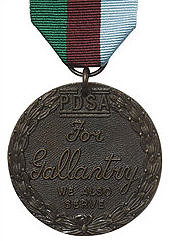 Treo's handler for five years, Sgt Dave Heyhoe, will also be there. Treo is now a family pet.
Treo's handler for five years, Sgt Dave Heyhoe, will also be there. Treo is now a family pet.
The Dickin Medal was started by vet charity PDSA and is the highest award an animal can get for gallantry or devotion to duty in a military conflict.
It was introduced in 1943 by PDSA founder Maria Dickin. Treo will be the 63rd animal to receive the medal.
A total of 26 other dogs, 32 Second World War messenger pigeons, three horses and one cat have won the medal.
To read the complete article, see:
A tail of Bravery
(www.thesun.co.uk/sol/homepage/news/campaigns/
our_boys/2843547/Hero-Labrador-with-a-tail-of-bravery.html)
THE NFL'S SUPER BOWL COIN TOSS STREAK
The Super Bowl coin toss has been an affront to fairness with the NFC winning 13 in a row!
If you thought this was a 50-50 proposition, you were dead wrong and you would have missed out on a chance to make a lot of money over the years. Unlike the game itself – where the AFC has won nine of 12 - the NFC almost always wins it and is currently on a devastating 15-2 run of Super Bowl coin toss victories.
We went looking for answers to the obvious question about how the NFC rigs the coin toss, which had produced a perfect split of 21 heads and 21 tails before last season’s Super Bowl (heads, won by Arizona by the way). But nobody was talking.
Super Bowl XLIV will see captains of each team gather at midfield to conduct the coin toss and sportsbooks the world over offer betting on it – will it be heads or tails and will the NFC or AFC win.
Tails would return the split to a perfect 22-22 through 44 games. And maybe the AFC doesn’t even want to win it. The last time they won was Super Bowl XXXI and the Patriots lost to the Packers. It’s enough to make oddsmakers do flips.
The official silver dollar the NFL uses for the all important coin toss has two sides - NFC North and NFC South," said industry veteran and linesmaker Dan Sharpstein.
To read the complete article, see:
NFC Lock to Win Super Bowl Coin Toss
(community.foxsports.com/oddsshark/blog
/2010/02/05/nfc_lock_to_win_super_bowl_coin_toss)
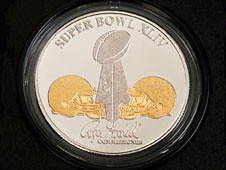 After traveling more than four million miles, and making 171 orbits around Earth on board space shuttle Atlantis, the Super Bowl XLIV opening-toss coin took a slight detour to the Pro Football Hall of Fame Museum in Canton, Ohio, on Jan. 27, before heading to the Super Bowl.
After traveling more than four million miles, and making 171 orbits around Earth on board space shuttle Atlantis, the Super Bowl XLIV opening-toss coin took a slight detour to the Pro Football Hall of Fame Museum in Canton, Ohio, on Jan. 27, before heading to the Super Bowl.
The coin was flown last November on STS-129 by crew members Commander Charlie Hobaugh, Pilot Barry Wilmore, and Mission Specialists Leland Melvin, Randy Bresnik, Mike Foreman and Bobby Satcher.
After stopping at the Hall of Fame, the coin will journey to Sun Life Stadium in Miami Gardens, Fla., to be the one of the stars of the Super Bowl XLIV pre-game coin toss on Feb. 7.
Out-of-This-World Super Bowl Coin Lands in Ohio (www.nasa.gov/mission_pages/shuttle/shuttlemissions/sts129/super_bowl_coin.html)
To read the earlier E-Sylum article, see: SUPER BOWL COIN TOSS TO USE NASA SPACE VETERAN MEDAL (www.coinbooks.org/esylum_v13n04a19.html)
QUERY: DEAR JOHN MOVIE'S NUMISMATIC SUBTHEME
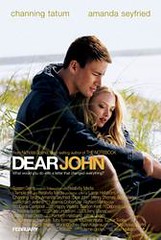 A movie review published this we contains this teaser:
A movie review published this we contains this teaser:
There's a metaphorical numismatic-themed subplot running through the narrative that ought to interest -- well -- numismatists, I guess.
So, what gives? If anyone learns what the numismatic subtheme is, please let us know. -Editor
To read the complete article, see: Movie review: Dear John (www.pegasusnews.com/news/2010/feb/05/movie-review-dear-john/)
FEATURED WEB SITE: A HISTORY OF THE WORLD
This week's Featured Web site is suggested by David Sundman, who writes:
Here is an interesting series by the British Museum and the BBC promoting a history of the world in 100 objects, some of which are coins, of course.

Domitianus' reign lasted only a few weeks, and with no literary references to his being emperor, the only evidence for his existence and rule derives from two coins. The first was discovered in France in 1900, the second, now in the Ashmolean Museum, was found in a pot with 5,000 other coins of the period 250-275, thus providing firm provenance, in the village of Chalgrove in Oxfordshire, in 2003.
The design of both coins is typical of those associated with the 'Gallic Empire'. They are of the "radiate" type and depict Domitianus as a bearded figure wearing a spiky or radiate crown representing the rays of the sun, and bearing the legend, IMP C DOMITIANUS P F AUG, an abbreviation for 'Imperator Caesar Domitianus Pius Flavius Augustus'.
The reverse of this coin shows 'Concord', the Roman goddess of agreement, understanding, and marital harmony.Domitianus was probably a Roman soldier of the mid-third century AD who was acclaimed Emperor, probably in northern Gaul, in late 270 or early 271 AD and struck coins to advertise his elevation.
www.bbc.co.uk/ahistoryoftheworld/
